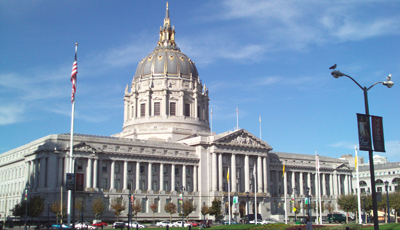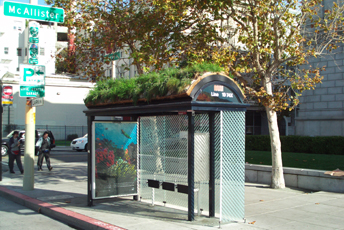A green makeover is being planned for San Francisco’s historic Civic Center area, thanks to a partnership forged by the City with the Clinton Global Initiative (CGI).

San Francisco’s City Hall will be one of the first municipal buildings to get a green makeover as part of the City’s partnership with the Clinton Global Initiative to create the country’s first green civic center. Photo by Bill Picture
By Bill Picture
Published: December, 2008
The brainchild of former President Bill Clinton, CGI brings together leaders from communities around the world to come up with solutions to global challenges.
The City and County of San Francisco, a CGI member, responded to the organization’s call for ideas to address global climate change with a three-year proposal to transform the area surrounding City Hall into the country’s first civic center sustainable resource district. The Commitment to Action calls for significant reductions in water use, energy use, wastewater discharge and carbon emissions, and specifies that 35 percent of the energy used during peak hours must come from renewable sources.
San Francisco Mayor Gavin Newsom believes that, by transforming the City’s municipal and cultural heart into a showcase for resource conservation, the City can inspire communities around the world to follow suit. Civic Center sits at the core of one of the most visited cities in the world, he told reporters at a September press conference. What better way to educate the world on sustainability than by transforming that core to showcase how we can use water more efficiently, promote food security and reduce our dependence on fossil fuels. Now, it will stand as a global model for how we achieve a more sustainable future.
We believe that San Francisco’s commitment shows government leadership in addressing global climate challenges and provides measurable and replicable results for cities worldwide, adds Astrid Haryati, Mayor Newsom’s Greening Director.
The goals set forth in the Commitment to Action were established by the City itself based on preliminary resource conservation studies of principal buildings, public right-of-ways and open spaces in the area. While the project will focus on city-owned property, Haryati says she intends to approach state and federal officials as well to discuss retrofitting their Civic Center-adjacent properties.
City Hall and the neighboring main branch of the San Francisco Public Library are at the top of the City’s to green list, with other principal public buildings to follow. Both City Hall and the Main Library are currently undergoing engineering evaluations to determine where immediate resource-efficiency improvements can be made. Among the proposed quick fixes is the installation of water-conserving plumbing fixtures. The solar-panel capacity of both buildings is also being determined. If all goes well, these initial projects should begin sometime next year.
Living roofs, like the one atop the new California Academy of Sciences, are also being considered. Living roofs—roofs planted with turf, shrubs and plants—provide better insulation than standard roofs, reduce rainwater runoff, and provide a habitat for birds and insects.
Out in the open
When it comes time to green signature public spaces—such as Civic Center Plaza, the Fulton Mall (Fulton Street, between Hyde and Larkin Streets) and United Nations Plaza—the public will be encouraged to add its two cents. The program development process for these high-visibility areas will include community dialogue to help identify and prioritize specific future projects.
Haryati believes the public will play a key role in shaping a vision for Civic Center, and expects that the final plan will include not only buildings and outdoor spaces, but also the streets and sidewalks that connect them. We expect to see a full array of green strategies demonstrating sustainable power, water and wastewater, she says. However, the specific manifestation of this vision will still need to be detailed during the program development process. Among the many ideas being considered for outdoor areas is a working garden to promote urban agriculture.
Naturally, visitors will be afforded better visual access to the green features in outdoor public areas than they will be to those in and/or on buildings. Still, Haryati says that no opportunity to educate and inspire visitors will be missed. When visual access is limited or impaired, interpretive signage will be used to share the program’s educational message. That is part of our commitment—educating the public about sustainable concepts, she explains.
Tracking change
If San Francisco is to inspire other municipalities to follow its green example, it must be able to prove that its strategies are working. So the City will work closely with the Clinton Climate Initiative (CCI) to come up with quantitative proof. CCI’s globally-accepted measurement methods will be used to track energy savings and greenhouse gas emission reductions. Results will be published in an annual report.
Check, please!
The San Francisco Public Utilities Commission is footing the bill for most of the already-identified building retrofits, including the installation of the solar panels on the roofs of City Hall and the Main Library. The cost to retrofit the other city-owned buildings and public spaces will not be known until a list of projects for those properties is finalized. Once that list is completed and expenses tallied, the next step will be finding the money to cover those projects, some of which may extend beyond the initial three-year deadline.
CGI is not a bank and does not provide funding; the organization can, however, help its members find funding. And San Francisco will likely take advantage of that service.
Leaving room for more
The framework plan being developed by the City will serve as a guide to follow, but it is not set in stone. Harvati says that, in order to ensure that Civic Center 2.0 is as green as it can be, plenty of bending room is being left in that framework to allow for new technology that may come online over the course of the next three years to be utilized.
As a district that is envisioned to be a global center for education and an incubator for innovative concepts, the framework plan will provide a clear overarching vision while also providing flexibility for emerging technologies and concepts.
The country’s first ‘green civic center’
San Francisco’s plan for an energy- and water-efficient civic center is intended to transform the City’s municipal and cultural heart into a global education center on sustainable concepts.
The goals of the sustainable resource district are:
80% potable water use reduction
45% wastewater discharge reduction
35% peak power demand met by renewables
33% annual energy reduction
2,225-ton reduction in greenhouse gas emissions

Solar panels will be installed next year atop the main branch of the San Francisco Public Library. As part of its Commitment to Action, the City intends to meet more than one-third of Civic Center’s peak-time energy demands with renewable sources. Photo by Bill Picture

Living roofs, like this one atop a Civic Center bus stop, are one of many green features being considered for city-owned properties. Livings roofs provide better insulation than traditional roofs, reduce rainwater discharge and provide a habitat for birds and insects. Photo by Bill Picture

